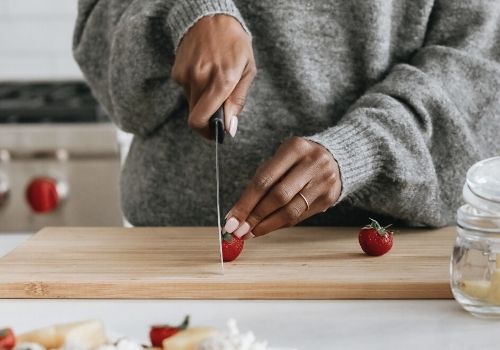15 Healthy Snacking Habits to Start Right Now
Who doesn’t love snacks? Maybe they’re even you’re favorite “meal”?
Snacks are a bigger part of your day than you might even realize. They help keep you energized and can even add an element of fun to an otherwise long day at work.
Snacks help keep those hunger pangs away in between meals, plus keep the kiddos occupied for long enough for you to regain some sanity.
They can be social when you share them, and they can even be a conversation starter. They add to experiences such as watching a movie, date night, and even work conferences.
Healthy snacking habits help to encourage all of these amazing things.
Snacks can also be a source of guilt, fatigue, weight gain, and even chronic disease if you develop a habit of unhealthy snacking though.
That’s when snacks aren’t so lovable.
Snacking should be a source of energy, pleasure, social connection, and nutrients to feed your body. Not a source of internal conflict or sugar crashes.
So, I’m going to share 15 healthy snacking habits to start right now, so you can make sure snacking stays lovable. These habits will keep the joy in snacking, while also keeping your pant size from going up.
P.S. I left the best for last, so read through to the end. (Don’t skip ahead though, that’s cheating.)
#1 Don’t Buy Snacks When You’re Hungry, Stressed or Sad
You may find yourself at the grocery store and all of a sudden realize like you haven’t eaten in ages. That’s because the sights and smells of the delicious foods on the shelves and at the corner bakery can trigger you to add them to your cart.
It’s made even worse if you really haven’t eaten in a few hours and those hunger signals are screaming for attention.
You’ll be more tempted to choose snacks that are highly satisfying, typically ones high in fat, carbohydrates, and artificial sugar. Snacks such as bags of chips and pretzels, boxes of crackers or packages of cookies will take precedence over the fruit, veggies and hummus, and Greek yogurt.
Also, void going to the grocery store when feeling any negative emotion like stress, boredom, anger, sadness. You’ll be more likely to want to make yourself feel a little better with a deliciously unhealthy snack, which is only a very quick hit of pleasure. (You’ll feel worse afterward.)
- Related: Are You Eating Because You’re Hungry?
- GET WEEKLY TIPS: Eating Habit and Weight Loss Tips
#2 Choose Snacks with Fiber
Choosing snacks with lots of fiber will help you to feel fuller, longer. You’ll be less likely to eat more calories than you need with your next meal. Plus, fiber is amazing for your digestive system. Just don’t overdo it, otherwise that hour-long work meeting might be really uncomfortable.
Once you start getting used to looking for snacks that are high in fiber, such as fruit or vegetables with hummus, you’ll start creating that healthy snacking habit with little effort.
#3 Never Eat Straight From the Box or Bag
This one is for obvious reasons. If you eat straight from the box or bag, you’ll end up overeating almost every time.
This takes a lot of practice of restraint to avoid overeating when eating straight from the bag or box. You can certainly work on restraint, but you have to use your pre-frontal cortex (the part of your brain that is always thinking about your future) for that.
#4 Put Healthy Snacks on the Counter in a Pretty Bowl
When you have healthy snacks such as fruit or nuts in plain sight, you’re more likely to reach for them, rather than the unhealthy snack hidden away in the cabinet.
If you have them in an eye-catching beautiful bowl, you’ll be even more drawn to them, making the healthy snacking choice.
When you always have a healthy snack out in plain sight, you’ll start forming a healthy snacking habit just simply from the repetition.
#5 Avoid Ultra-Processed Snacks
Processed foods or snacks are ones where the ingredients are broken down into tiny particles (think flour). Examples are crackers, cookies, pretzels, chips. Foods like hot dogs are also processed, but meat rather than grains.
The problem with processed foods, particularly ones consist of flour or sugar, is that these enter your blood stream and raise your blood glucose (blood sugar) very quickly.
Unfortunately, your blood glucose then falls quickly, leaving you uncomfortable and craving more, amongst other negative effects on your body.
- Related: Should You Break Your Habit of Snacking at Night?
- GET WEEKLY TIPS: Eating Habit and Weight Loss Tips
#6 Cut up Fruit & Veggies Before Putting in Refrigerator
When you get home from the market or grocery store, cut up some fruit and veggies and place in containers in your fridge. That way, they are easy to grab when looking for a snack.
You’re more likely to create healthy snacking habits if you make the healthy choice, the easy choice.

#7 Place Unhealthy Snacks in a Hard to Reach Spot
On the flip side, make unhealthy snacks harder to get to.
For example, you can place any unhealthy snacks you have (or the people you live with have) behind other items in the back of the cabinet or pantry.
If they are out of sight and you have to dig to get to them, you’re less likely to snack on them, especially if in a rush.
#8 Choose Dark Chocolate Over Milk Chocolate
Dark chocolate has less sugar than milk or even semi-sweet chocolate. Dark chocolate is also rich in antioxidants, more so than milk chocolate. For more reading on that, check out this article from Harvard’s School of Public Health.
Once you start getting choosing dark chocolate over milk chocolate, you’ll feel like the dark chocolate is sweet enough. If that’s too much of a transition, try semi-sweet first a few times, then go dark.
#9 Mix a Healthy Snack With an Unhealthy One
Sometimes a healthy snacking habit is to simply mix a healthy snack with an unhealthy one that you may already be in the habit of eating. For example, if you normally eat two chocolate chip cookies, then eat one chocolate chip cookie and a handful of grapes instead.
Eating habits can be tough to break, so start off with something you think you can do. You’re going to want to show your brain some proof that you can develop healthy snacking habits. This can be done by making a change that is easy for you for where you’re currently at.
#10 Drink Water or Seltzer While Snacking
We oftentimes don’t get enough water, so drinking water or seltzer (bubbly water) serves two purposes. One, to fill you up more so you don’t overeat the snack, and two, to hydrate you.
Seltzer works particularly well for this. Try adding a piece of fruit to your seltzer to dress it up a bit.
#11 Choose Snacks with Natural Rather Than Artificial Sugar
Natural sugars found in fruit are so much healthier than artificial sugar and a main reason is because they only minimally raise the blood glucose compared to artificial sugar.
That means, natural sugars won’t give you that big sugar crash, leading to fatigue or craving more sugar.
#12 Keep Snacks to 300 Calories or Less
Snacks aren’t meals, and only need to hold you over to your next meal. 300 calories is typically the maximum amount of calories you need to fuel you for another hour or two.
You will be tempted to eat more, because that’s just how your human brain works. So just try to remember that you don’t need to eat an 800-calorie snack. Save that for dinner.
- Related: 5 Clever Ways to End Overeating
#13 Avoid Snacks With Alot of Chemicals
You’re going to want to put real food in your body, not chemicals with a sprinkling of real food. Just be mindful of those ingredient lists.
Chemicals in food can leave us feeling like we didn’t eat enough because they don’t signal to the brain that we’ve gotten the nutrients we need. This can lead to overeating, not to mention feeling very unsatisfied.
#14 Choose a Specific Time to Snack
If you choose a specific time during your day to have a snack, you’ll develop a habit of ONLY eating a snack during that time. Your body will get used to snacking at that time and you’ll notice that it’s almost like clockwork.
You’ll then be less likely to randomly snack when you don’t necessarily need the calories.
#15 When Snacking, Only Snack
If you want to start on just one of these healthy snacking habits that will serve you the most, then this one is it. When you snack, just concentrate on snacking. You’ll enjoy the snack more, plus won’t be as likely to overeat.
This means, don’t snack and do another task at the same time, When you’re doing another task, you’re concentrating more on that task and less on eating, so can end up overeating quite easily.
Final Notes on Healthy Snacking Habits
Whatever your current snacking habits are, make sure to meet yourself halfway. Healthy snacking habits take time to develop, which is why I encourage you to start a few today.
Repeating a few healthy snacking habits daily for several weeks will start to break those unhealthy snacking habits and form new, healthy snacking habits that will stick.
Just a few small changes now can benefit your future significantly.

KATE JOHNSTON
Weight Loss Coach, PA-C
Helping busy career women lose weight simply, by changing their eating habits (and mindset) for life.
Want to see how I can help you specifically? Just with the free consultation, you’ll get insight, clarity, and direction that’ll move you forward.
